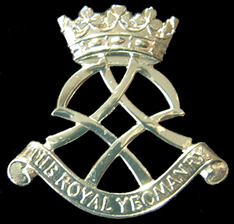Royal Yeomanry
This article includes a list of references, related reading, or external links, but its sources remain unclear because it lacks inline citations. (January 2013) |
| The Royal Yeomanry | |
|---|---|
 Cap badge of the Royal Yeomanry | |
| Active | 1 April 1967- |
| Country | United Kingdom |
| Branch | Army Reserve |
| Type | Yeomanry |
| Role | Light Cavalry |
| Size | One regiment |
| Part of | Royal Armoured Corps |
| Garrison/HQ | RHQ - Croydon A Squadron - Swindon B Squadron - Leicester C Squadron - Croydon S Squadron - Nottingham W Squadron - London |
| March | The Farmers Boy |
| Engagements | Iraq 2003 |
| Commanders | |
| Current commander | Lt Col Kingsley Donaldson RTR |
| Royal Honorary Colonel | HRH Princess Alexandra, The Honourable Lady Ogilvy LG GCVO |
| Honorary Colonel | Lt-General Sir BWB White-Spunner KCB CBE |
| Insignia | |
| Tactical Recognition Flash |  |

The Royal Yeomanry (RY) is an armoured regiment of the Army Reserve consisting of five squadrons and a military band:
- A (Royal Wiltshire Yeomanry) Squadron (Swindon)
- B (Leicestershire and Derbyshire Yeomanry) Squadron (Leicester)
- C (Kent and Sharpshooters Yeomanry) Squadron (Croydon)
- S (Sherwood Rangers Yeomanry) Squadron (Nottingham)
- W (Westminster Dragoons) Squadron (London)
- The Royal Yeomanry Band (Inns of Court and City Yeomanry) (London)
The Royal Yeomanry's role is light cavalry: providing a rapidly-deployable force with fast mobility and substantial firepower as part of the British Army's combat arm. Its soldiers provide reconnaissance, reassurance, security and, if the situation demands it, decisive tactical effects by raiding and attacking the enemy.[1]
History

The Royal Yeomanry was formed in 1967, following the amalgamation of six distinguished county yeomanry regiments, as a medium reconnaissance regiment equipped with armoured cars. It continued in this role until 1996, when it became the British Army's NBC defence regiment. It served exclusively in this role until 1999, when the Joint NBC Regiment was formed. Two of the Royal Yeomanry's squadrons, A Squadron and the W Squadron, were retained in the NBC role to provide reserves for front line NBC troops. The remaining three converted to the Challenger 2 to serve as reserves for armoured regiments.
Under the restructuring of the Territorial Army announced in March 2006, all five squadrons of the Royal Yeomanry adopted the role of formation CBRN reconnaissance and the regiment's established strength increased to 561 personnel. Under the Army 2020 programme, the Royal Yeomanry was given a new role, that of light cavalry.
Operational service

Members of the Royal Yeomanry have served as individual replacements on operations in Kuwait and the Former Yugoslavia. The regiment's most significant deployments have been to Iraq.
In January 2003, W Squadron and A Squadron were mobilised for Operation TELIC, the war in Iraq. The two squadrons were amalgamated with a number of augmentees from the other three squadrons and from the Royal Logistic Corps to form a much-enlarged "Y" Squadron of the Joint NBC Regiment.
This was the first deployment of a formed TA unit (TA soldiers under TA command) for combat operations since the Suez crisis in 1956. During the war, officers and soldiers of the Royal Yeomanry found themselves serving with 16 Air Assault Brigade, 7 Armoured Brigade (the Desert Rats) and 3 Commando Brigade as NBC specialists, before switching roles to infantry “peace support” operations once Saddam Hussein’s regime had collapsed.[2]
The Royal Yeomanry has maintained a constant presence in Iraq since March 2003. The regiment's soldiers have been mobilised for each of the subsequent TELICs. Of these, the largest deployment was for TELIC 4 in 2004, when soldiers and officers from B, C and S Squadrons were despatched to augment the Queen's Royal Lancers and 1st Battalion the Princess of Wales' Royal Regiment, serving principally as infantry but also in the armoured role. Since 2007, the Royal Yeomanry has provided officers and soldiers as individual replacements on Operation HERRICK in Afghanistan.
Future
In preparation for its change of role from CBRN reconnaissance to light cavalry, the regiment acquired its first RWMIK vehicles in 2012.
Under Army 2020, it is proposed that the Royal Yeomanry will lose two squadrons (A and B). [3] That decision is under review. The regiment will gain a squadron from the Royal Mercian and Lancastrian Yeomanry in April 2014. It will retain its HQ Sqn (W Sqn having converted to that role in 2010).
The Royal Yeomanry will be paired with 1st The Queen's Dragoon Guards and be under the command of 7th Infantry Brigade.[4]
Battle honours
- Iraq 2003
As a result of the regiment's initial service during the Iraq war, the Royal Yeomanry was in 2005 awarded the theatre honour "Iraq 2003", the first battle honour the regiment has won since its formation, and the first - so far the only - battle honour awarded to a Territorial Army regiment since the Second World War.[5]
The squadrons forming the Royal Yeomanry also hold a large number of battle honours won by their predecessor regiments and retain the right to parade their respective guidon.
Lineage
External links
- Official Regimental website
- Leicestershire and Derbyshire Yeomanry Unofficial Website
- Westminster Dragoons Unofficial Website
- Kent & Sharpshooters Yeomanry Unofficial Website
- Kent and Sharpshooters Yeomanry Museum Unofficial Website
- C Sqn Royal Yeomanry Recruiting Unofficial Website
References
- ^ http://www.army.mod.uk/armoured/regiments/26880.aspx
- ^ Ministry of Defence, "Future Reserves 2020 Study (FR20): final report", 1 July 2011, page 12.
- ^ http://www.army.mod.uk/documents/general/20130703-SUMMARY_OF_ARMY_2020_RESERVE_STRUCTURE_AND_BASING.pdf Ministry of Defence, "Summary of Army 2020 Reserve Structure and Basing Changes", pp 1 and 2.
- ^ http://www.army.mod.uk/documents/general/Army2020_Report.pdf page 9, 11
- ^ http://www.army.mod.uk/armoured/regiments/28587.aspx
